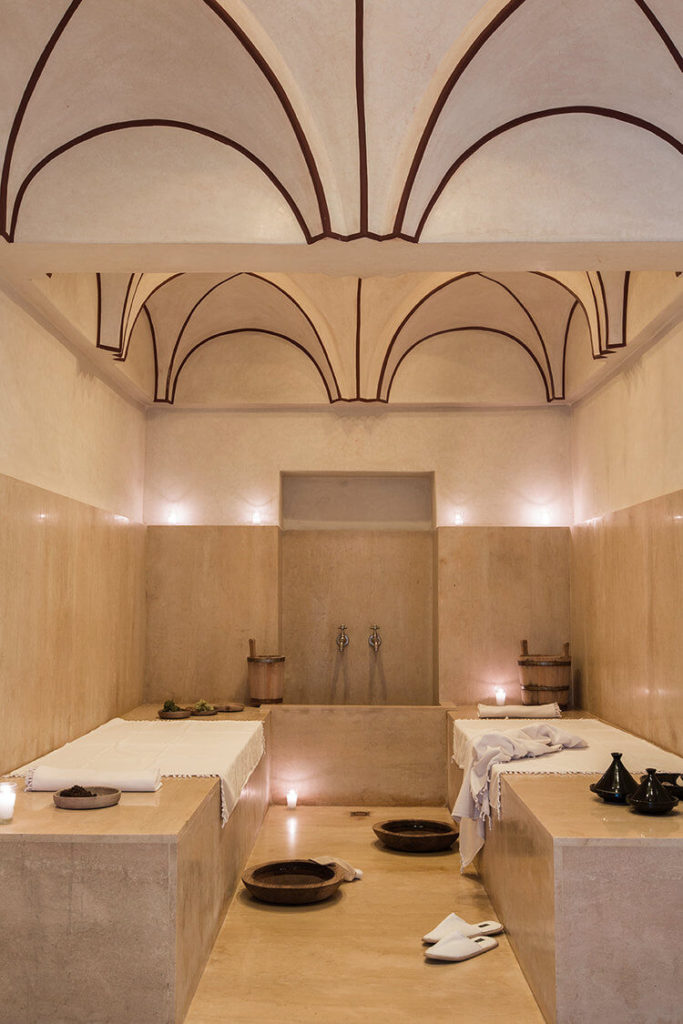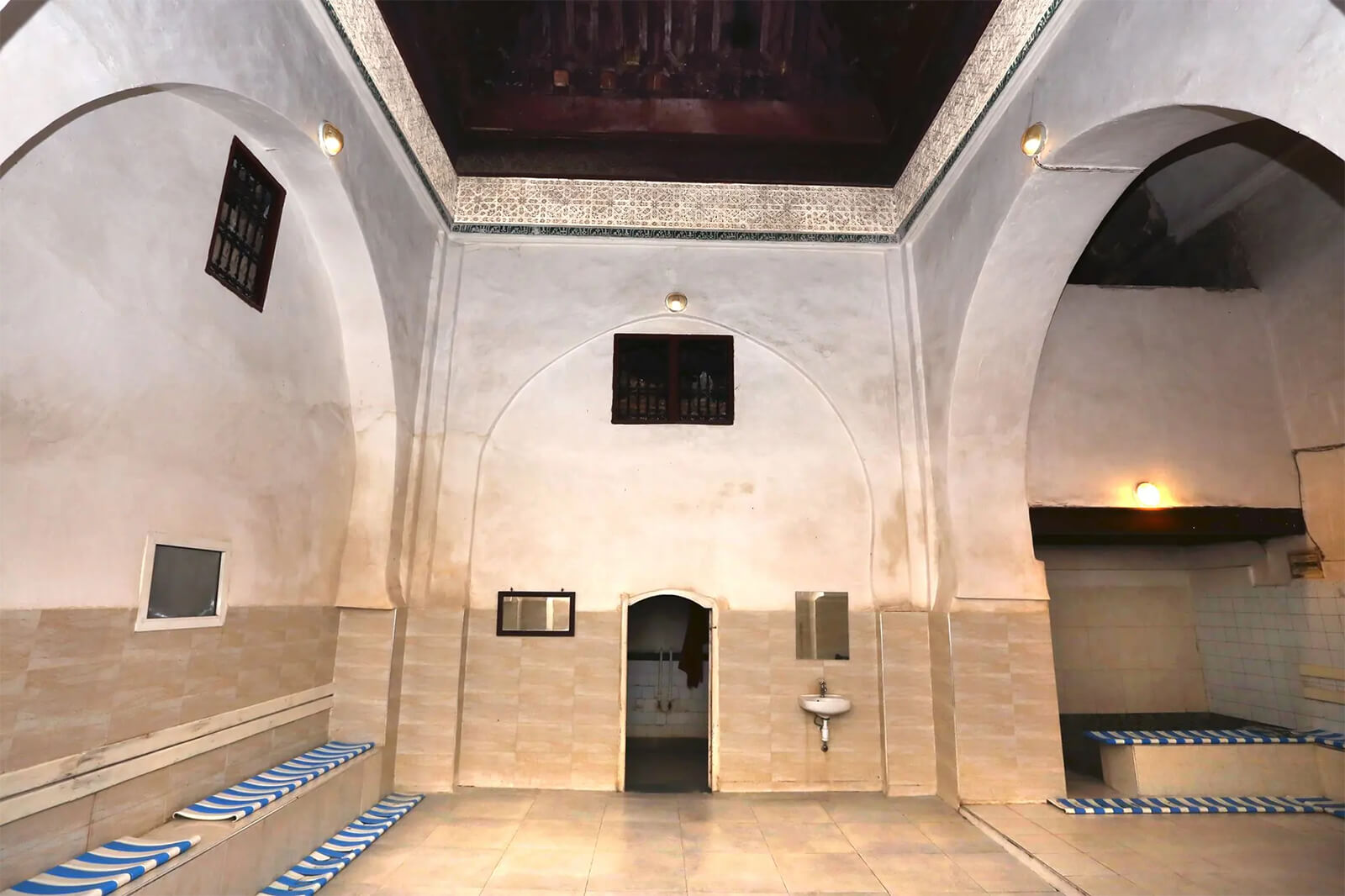Visiting a Moroccan hammam isn’t just about self-care; it’s a fantastic opportunity to experience Moroccan culture up close and enjoy a truly authentic experience, or simply indulge in an extended wellness session.
After a night in the desert, a hammam is usually the only practical way to scrub away the last grains of desert sand. But a Moroccan hammam offers much more than just a body care routine. In the dimly lit warmth of these traditional bathhouses, sitting side by side in swimwear, you’ll find a chance to connect with locals on a deeper level than just a casual chat in a café. Don’t miss out on such rare opportunities for authentic exchanges!
In this post, you’ll learn more about the history of Moroccan bathhouses and their relevance today. I will also give you practical tips on how to visit a classic hammam in Morocco, what to expect, and what to bring along.
Contents
- 1 What is a hammam?
- 2 The role of public hammams in Moroccan society
- 3 The history of hammams in Morocco
- 4 Architecture and layout of Moroccan hammams
- 5 How does a hammam visit in Morocco work?
- 6 The bathing ritual
- 7 The Tebbaya
- 8 Wellness and Spa
- 9 What you should bring to a public hammam
- 10 Frequently asked questions about hammams and baths in Morocco
What is a hammam?
A hammam is a traditional bathhouse that typically consists of several rooms with varying temperatures. It is used for relaxation and deep body cleansing. Originating from Arab and Turkish cultures, hammams have played an essential role in daily hygiene and body care for centuries.
Unlike thermal baths, Moroccan hammams use hot steam instead of thermal water to provide a deep and revitalizing cleansing.
Public hammams
These affordable bathhouses are still found in the old medinas of every major Moroccan city and even in modern neighborhoods. These serve as essential spaces for physical hygiene and act as social meeting places. Entrance fees are usually around 10 DH.
Private hammams and spas
In contrast, for a more luxurious and private experience, private hammams and spas offer wellness-focused treatments, perfect for relaxation. Prices start at around 100 DH and vary depending on the service. These upscale options are popular among tourists and wealthier locals.

The role of public hammams in Moroccan society
Public hammams hold a significant place in Moroccan medinas, often considered the second most important building after mosques. Along with the community bakery, fountain, and madrasa (Quran school), they are one of the five traditional elements in every medina quarter.
Hammams are more than just spaces for bathing—they are deeply woven into Morocco’s cultural identity. They often serve as social hubs, bringing together people of different social classes to interact, exchange news, and connect with friends and relatives.
In rural areas, hammams are especially important, as many homes lack private bathrooms.
Traditionally, the hammams are heated by a Farnatchi, a man responsible for maintaining the fire under the bathhouse, which heats the floors and walls. Interestingly, the Farnatchi is also entrusted with preparing the Tangia, a traditional Marrakech stew, which cooks slowly in a clay amphora over the same fire.
Visiting a hammam is a weekly ritual for most Moroccans, regardless of their social status. Thursdays and Fridays are particularly popular days, as the hammam visit often precedes the important Friday prayer.
The history of hammams in Morocco
The origins of hammams in Morocco trace back to the late 8th century, with the ruins of the oldest known bathhouse located in Volubilis. These ancient structures highlight the deeply rooted tradition of hammams, influenced by Roman and Arab cultures.
Over time, hammams became an essential part of Moroccan daily life. Today, Morocco has the highest number of bathhouses worldwide. It is estimated that there are about 5,000 public and private hammams in Morocco, frequented by people of all social classes. Cities like Marrakech and mainly Fez are especially notable for preserving many historical hammams. In Fez alone, around 30 traditional bathhouses still operate.
Architecture and layout of Moroccan hammams
Moroccan hammams are typically smaller than their Roman or Byzantine counterparts. Unlike free-standing bathhouses found in other cultures, they seamlessly blend into the surrounding architecture. Inconspicuous, windowless facades and L-shaped entrances often make them hard to recognize, so they are far from being monumental buildings.
The most defining architectural feature is the characteristic domes, which hint at the three-room structure. These domes, adorned with small glass windows, allow soft, diffused light to enter, creating a serene and tranquil atmosphere.
The rooms in detail:
- Warm room: stimulates the circulation and opens the pores
- Hot room: intense cleaning and peelings
- Cool room: designed for relaxation and stabilizing the body’s temperature
How does a hammam visit in Morocco work?
Most Moroccan hammams are gender-separated. They have two separate entrances or offer different opening hours for women and men.
Arrival and preparation
As soon as you enter a hammam, you’ll usually step into a private changing room. Here’s what to expect:
- Pay the entrance fee: Hand it to the staff, who will also guide you to the facilities.
- Store your belongings: Use shelves or lockers to keep your items secure.
- What to wear: Men typically wear swim trunks in the hammam, while women opt for bikini bottoms.
I recommend observing the locals to align with cultural norms. But don’t worry—based on my experience, you are highly well-received as a tourist in a public hammam.
The bathing ritual
You step into the heated hammam area through the changing room door. Inside, you’ll find three interconnected spaces: the warm room, the hot room, and the cool room.
You start in the warm room, where the temperature ranges from 40 to 50°C. This is where your body begins to acclimatize. To prepare, you mix hot and cold water in one of the provided plastic buckets or your own cup until the temperature feels just right. Then, you wash yourself thoroughly. Washing is usually done while sitting, which allows you to relax and immerse yourself in the soothing warm water.
Once you’re ready, you move on to the hot room. In a hammam, shower gel is rarely used. Instead, you’ll often find traditional Savon Noir, a black soap made from olive oil and the pulp of black olives. You can buy it in the souk or directly at the hammam. This natural soap leaves your skin feeling soft and perfectly primed for the next step: peeling.
The Tebbaya
The actual peeling is carried out using a Kess, a scrubbing glove with a relatively rough texture designed to exfoliate your skin. In public hammams, it’s common for friends or family members to scrub each other. However, if you’d rather not do it yourself, you can trust the Tebbaya, an expert in bathing and massage. These professionals work directly in the hammam and are happy to guide first-timers through the hammam experience.
With the Tebbaya’s skilled assistance, the scrubbing and rubbing are thorough and efficient. Dead skin cells are removed without much fuss. This process can feel intense, especially if you’re new to it. Be prepared for every inch of your body to be treated—including sensitive areas like the chest, forearms, and the insides of your thighs. While it might feel slightly uncomfortable, and your skin may appear reddened afterward, this is entirely normal and part of the experience.
The cost for a massage or peeling by a Tebbaya typically ranges between 30 and 50 DH. After the peeling, you head to the cool room, where you can relax and let your circulation stabilize.
Wellness and Spa
The bathing ritual in private hammams is quite different. They often include a more exclusive spa program. Here, you enjoy the facilities privately. The focus shifts to relaxation and wellness, offering a pampering contrast to the social atmosphere of public hammams.
In addition to the peeling, many private hammams extend the ritual with soothing massages, detoxing face masks, or treatments using Ghassoul—a mineral-rich clay known for its antibacterial and cleansing properties. This clay draws toxins to the surface, leaving your skin revitalized. To finish, the treatments often include a hair tonic made from orange blossom water or lemon juice.
What you should bring to a public hammam
To ensure a smooth visit, pack these essentials:
- Bath slippers or sandals
- A towel
- A Kess (the scrubbing glove)
- Savon Noir (black soap)
- Shampoo, shower gel, or soap
- Swim trunks or bikini bottoms
- A change of clothes
- Small change for entrance fees, peeling, or massages
If you forget something, don’t worry. You can purchase items like soap or a scrubbing glove in the souk. Many hammams also provide the listed things for a small fee.
Frequently asked questions about hammams and baths in Morocco
It is customary to eat or drink something after a hammam session. Enjoy a traditional bowl of Harira in the hammam or at one of the cafes or restaurants nearby.
Entrance fees range from 10 to 20 DH, with peeling an additional 30 DH.
Prices vary depending on the chosen service and location. A traditional hammam treatment usually includes peeling and a massage and ranges between 150 and 200 DH. More luxurious packages which include additional wellness services such as aromatherapy or facials may be more expensive. It is recommended to compare prices in advance.
Yes, many hammams provide massages, often as part of a complete cleansing ritual. Some hammams even offer fitness or yoga classes in the warmth of the rooms.
In Morocco, most hammams operate with separate facilities or schedules for men and women.
Men usually wear swim trunks in the hammam, while women often wear swimsuits or bikinis.
Hammams use steam and focus on cleansing and relaxation. Saunas rely on dry heat to promote sweating and cardiovascular benefits.
In traditional hammams, cosmetic products or wellness treatments are generally not offered. The focus is primarily on cleansing and relaxing.
It is recommended to leave valuables at home and only bring the essentials. Most public hammams do not have lockers.
Yes, you can order the cosmetics used in the hammam, like Savon Noir or Ghassoul, on the internet.


